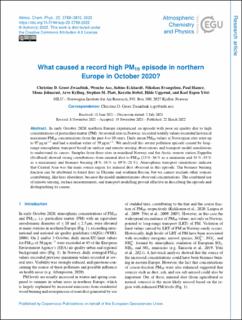| dc.contributor.author | Zwaaftink, Christine Groot | |
| dc.contributor.author | Aas, Wenche | |
| dc.contributor.author | Eckhardt, Sabine | |
| dc.contributor.author | Evangeliou, Nikolaos | |
| dc.contributor.author | Hamer, Paul David | |
| dc.contributor.author | Johnsrud, Mona | |
| dc.contributor.author | Kylling, Arve | |
| dc.contributor.author | Platt, Stephen Matthew | |
| dc.contributor.author | Stebel, Kerstin | |
| dc.contributor.author | Uggerud, Hilde Thelle | |
| dc.contributor.author | Yttri, Karl Espen | |
| dc.date.accessioned | 2022-04-04T12:12:00Z | |
| dc.date.available | 2022-04-04T12:12:00Z | |
| dc.date.created | 2022-03-28T11:05:50Z | |
| dc.date.issued | 2022 | |
| dc.identifier.citation | Atmospheric Chemistry and Physics (ACP). 2022, 22, 3789-3810. | en_US |
| dc.identifier.issn | 1680-7316 | |
| dc.identifier.uri | https://hdl.handle.net/11250/2989636 | |
| dc.description.abstract | In early October 2020, northern Europe experienced an episode with poor air quality due to high concentrations of particulate matter (PM). At several sites in Norway, recorded weekly values exceeded historical maximum PM10 concentrations from the past 4 to 10 years. Daily mean PM10 values at Norwegian sites were up to 97 µg m−3 and had a median value of 59 µg m−3. We analysed this severe pollution episode caused by long-range atmospheric transport based on surface and remote sensing observations and transport model simulations to understand its causes. Samples from three sites in mainland Norway and the Arctic remote station Zeppelin (Svalbard) showed strong contributions from mineral dust to PM10 (23 %–36 % as a minimum and 31 %–45 % as a maximum) and biomass burning (8 %–16 % to 19 %–21 %). Atmospheric transport simulations indicate that Central Asia was the main source region for mineral dust observed in this episode. The biomass burning fraction can be attributed to forest fires in Ukraine and southern Russia, but we cannot exclude other sources contributing, like fires elsewhere, because the model underestimates observed concentrations. The combined use of remote sensing, surface measurements, and transport modelling proved effective in describing the episode and distinguishing its causes. | en_US |
| dc.language.iso | eng | en_US |
| dc.rights | Navngivelse 4.0 Internasjonal | * |
| dc.rights.uri | http://creativecommons.org/licenses/by/4.0/deed.no | * |
| dc.title | What caused a record high PM10 episode in northern Europe in October 2020? | en_US |
| dc.type | Peer reviewed | en_US |
| dc.type | Journal article | en_US |
| dc.description.version | publishedVersion | en_US |
| dc.rights.holder | © Author(s) 2022. | en_US |
| dc.source.pagenumber | 3789-3810 | en_US |
| dc.source.volume | 22 | en_US |
| dc.source.journal | Atmospheric Chemistry and Physics (ACP) | en_US |
| dc.identifier.doi | 10.5194/acp-22-3789-2022 | |
| dc.identifier.cristin | 2012946 | |
| dc.relation.project | Miljødirektoratet: 21087006 | en_US |
| dc.relation.project | EC/FP7/262254 | en_US |
| dc.relation.project | NILU: 115058 | |
| dc.relation.project | NILU: 121002 | |
| dc.relation.project | NILU: 120007 | |
| cristin.ispublished | true | |
| cristin.fulltext | original | |
| cristin.qualitycode | 2 | |

